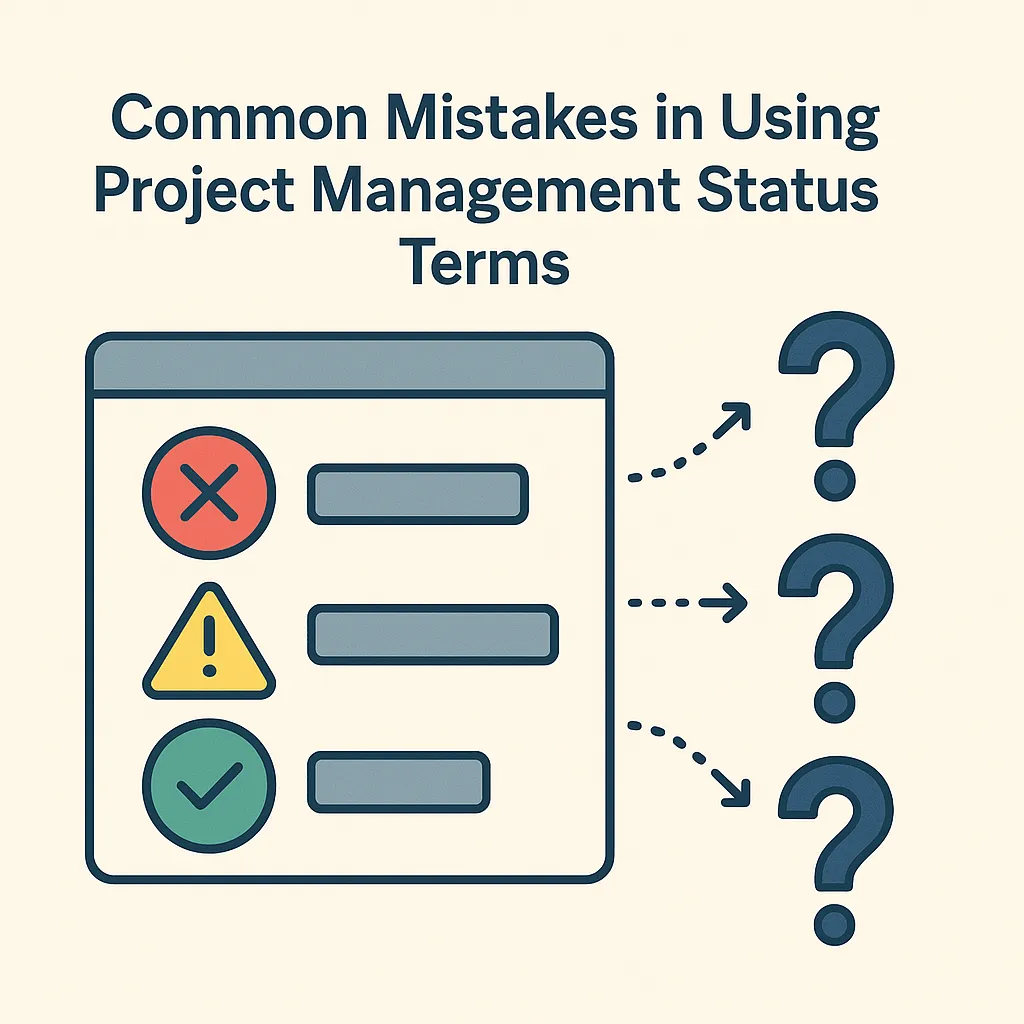Introduction
Effective communication is paramount to the success of any initiative. One of the critical components of this communication is the use of project management status terms. These terms serve as a common language among team members, stakeholders, and clients, providing clarity on the project’s progress, challenges, and overall health. However, the misuse or misunderstanding of these terms can lead to significant miscommunication, resulting in project delays, scope creep, and even failure.
Defining Project Management Status Terms
Project management status terms refer to the specific language and terminology used to describe the current state of a project. This includes terms like “on track,” “at risk,” “delayed,” and “completed.” Each term carries specific implications about the project’s progress and the actions required moving forward. For experienced project managers, understanding and utilizing these terms correctly is essential for maintaining transparency and alignment among all parties involved.
The Importance of Clear and Consistent Terminology
For seasoned project managers, the importance of clear and consistent terminology cannot be overstated. Misinterpretations can arise from vague or inconsistent use of status terms, leading to confusion among team members and stakeholders. This confusion can hinder decision-making processes and create unnecessary friction within the team. By establishing a standardized vocabulary, project managers can foster a more collaborative environment, ensuring that everyone is on the same page regarding project expectations and outcomes.
Common Mistakes to Avoid
In this blog post, we will explore several common mistakes that project managers often make when using status terms. These pitfalls include:
- Ambiguity in Terminology: Failing to define what specific terms mean within the context of a project can lead to misunderstandings.
- Inconsistent Usage: Using different terms to describe the same status can confuse team members and stakeholders.
- Overly Technical Language: Employing jargon that is not universally understood can alienate non-technical stakeholders.
- Neglecting Updates: Failing to regularly update status terms can create a false sense of security or urgency.
By identifying and addressing these common mistakes, experienced project managers can enhance their communication strategies, ultimately leading to more successful project outcomes.
Understanding Project Management Status Terms
Clear communication is paramount. Misunderstandings can lead to significant setbacks, making it essential for project managers to use status terms accurately. This section will clarify key project management status terms, their implications, and the importance of standardization in terminology.
Key Status Terms
- On Track:
- This term indicates that a project is progressing according to the planned schedule and budget. It suggests that all tasks are being completed as expected, and there are no significant issues affecting the timeline or resources.
- Implication: Stakeholders can feel confident that the project is moving forward as intended, which can enhance trust and support.
- At Risk:
- When a project is labeled as “at risk,” it signifies potential issues that could derail progress. This could be due to resource shortages, unforeseen challenges, or changes in project scope.
- Implication: This term serves as a warning to stakeholders that proactive measures may be needed to mitigate risks and keep the project on course. It encourages open dialogue about potential solutions.
- Delayed:
- A project status of “delayed” indicates that certain tasks or milestones are not being met within the expected timeframe. This can stem from various factors, including resource allocation issues or external dependencies.
- Implication: This term can raise concerns among stakeholders regarding project viability and may necessitate discussions about revised timelines and resource management strategies.
- Completed:
- This term signifies that all project tasks and deliverables have been finished, and the project has met its objectives. It is a critical status that marks the transition to project closure and evaluation.
- Implication: Stakeholders can assess the outcomes and benefits of the project, which is essential for future planning and resource allocation.
Context and Implications for Stakeholders
The context in which these terms are used is crucial. For instance, stating that a project is “at risk” during a stakeholder meeting can prompt immediate discussions about resource reallocation or strategy adjustments. Conversely, declaring a project “on track” can foster a sense of accomplishment and motivate the team. Misusing these terms, however, can lead to confusion and misalignment among stakeholders, potentially jeopardizing project success.
Importance of Standardization in Terminology
Standardizing project management status terms is vital for effective communication. When all team members and stakeholders understand and use the same terminology, it reduces the risk of misinterpretation. This consistency ensures that everyone is on the same page regarding project progress and challenges, facilitating better decision-making and collaboration.
Mistake 1: Inconsistent Terminology
the use of status terms is crucial for effective communication and project tracking. However, one of the most significant pitfalls experienced project managers encounter is inconsistent terminology. This inconsistency can lead to confusion, misinterpretation, and ultimately, project delays. Here are some key points to consider:
- Examples of Inconsistencies: Different team members or departments may use varying terms to describe the same project status. For instance, one team might refer to a project phase as “in progress,” while another might call it “ongoing” or “active.” Such discrepancies can create misunderstandings about the actual state of the project, leading to misaligned expectations and actions among stakeholders [6][9].
- Impact on Communication: When team members use different terms for the same status, it can result in significant confusion. For example, if one department believes a task is “completed” while another considers it “pending review,” this misalignment can cause delays in project timelines and hinder decision-making processes. The lack of a shared understanding can also lead to frustration among team members, as they may not be on the same page regarding project progress and priorities [2][10].
- Strategies for Consistency: To mitigate the risks associated with inconsistent terminology, project managers should develop a standardized lexicon that all team members agree upon. Here are some strategies to achieve this:
- Create a Glossary: Develop a comprehensive glossary of project management terms that includes definitions and examples. This document should be easily accessible to all team members and updated regularly to reflect any changes in terminology [5].
- Conduct Training Sessions: Organize training sessions to educate team members about the agreed-upon terminology. This can help reinforce the importance of using consistent terms and provide an opportunity for team members to ask questions and clarify any uncertainties [4].
- Regular Check-ins: Schedule regular meetings to review project status and ensure that everyone is using the same terminology. This practice can help identify any discrepancies early on and allow for timely corrections [3][8].
By addressing the issue of inconsistent terminology, experienced project managers can enhance communication within their teams, reduce the likelihood of misunderstandings, and ultimately drive project success.
Mistake 2: Overcomplicating Status Terms
Effective communication is paramount. However, one common pitfall that experienced project managers often encounter is the tendency to overcomplicate status terms. This can lead to miscommunication, confusion, and ultimately, project delays. Here are some key points to consider regarding this mistake:
- Examples of Jargon-Heavy Terms: Terms like “synergy,” “leverage,” or “paradigm shift” can be alienating for stakeholders who may not be familiar with such jargon. Additionally, phrases like “utilizing a holistic approach” or “implementing a robust framework” can obscure the actual status of a project. These terms may sound impressive but can confuse team members and stakeholders who are not well-versed in project management lingo [1].
- Tailoring Communication to the Audience: It is crucial to assess the audience’s level of understanding when communicating project status. Not all stakeholders have the same background or familiarity with technical terms. By simplifying language and avoiding jargon, project managers can ensure that everyone involved has a clear understanding of the project’s progress and challenges. This approach fosters better collaboration and decision-making [2].
- Advocating for Simplicity and Clarity: Emphasizing clarity in status updates is essential for enhancing comprehension. Using straightforward language and clear visuals can significantly improve the effectiveness of communication. For instance, instead of saying “the project is currently in the ideation phase,” a more accessible update could be “we are brainstorming ideas for the project.” This not only makes the information more digestible but also encourages engagement from all stakeholders [3].
Mistake 3: Neglecting Context
The use of status terms is crucial for effective communication among team members and stakeholders. However, one of the most significant pitfalls experienced project managers encounter is the neglect of context when using these terms. This oversight can lead to misunderstandings and miscommunication, ultimately jeopardizing project success. Here are some key points to consider:
- Varied Meanings of Status Terms: Status terms such as “on track,” “delayed,” or “at risk” can have different interpretations depending on the context in which they are used. Without a clear understanding of the specific circumstances surrounding these terms, stakeholders may draw incorrect conclusions about the project’s health. For instance, a project labeled as “delayed” might be perceived as severely off-course, while it could simply be experiencing minor setbacks that are manageable with proper adjustments. This ambiguity can lead to unnecessary panic or misallocation of resources [5].
- Importance of Project Updates: Regular project updates play a vital role in providing situational awareness to stakeholders. These updates should not only include the current status but also the context behind that status. For example, if a project is reported as “behind schedule,” it is essential to explain the reasons for the delay, such as unforeseen challenges or resource constraints. This transparency helps stakeholders understand the situation better and fosters trust in the project management process [8].
- Inclusion of Relevant Information: To avoid miscommunication, it is crucial to include relevant information when reporting status changes. This could involve detailing the factors that led to a change in status, the implications of that change, and the steps being taken to address any issues. By providing this context, project managers can ensure that all parties involved have a comprehensive understanding of the project’s trajectory, which aids in informed decision-making and enhances collaboration among team members [9].
Mistake 4: Ignoring Stakeholder Perspectives
Effective communication is paramount, particularly when it comes to conveying project status. One significant pitfall that experienced project managers often encounter is the failure to consider the diverse perspectives of stakeholders when using status terms. This oversight can lead to miscommunication, misunderstandings, and ultimately, project setbacks.
Different Interpretations of Status Terms
Stakeholders come from various backgrounds and hold different roles within a project, which can significantly influence how they interpret status terms. For instance:
- Executives may view terms like “on track” or “delayed” in the context of overall business objectives and financial implications, focusing on high-level outcomes rather than day-to-day operations.
- Team members might interpret the same terms based on their immediate tasks and responsibilities, leading to confusion if they feel their work is not aligned with the project’s stated status.
- Clients or end-users may have their own expectations and definitions of success, which can differ from those of the project team, potentially resulting in dissatisfaction if their perspectives are not considered.
This variance in interpretation underscores the necessity for project managers to be mindful of how status terms are communicated and understood across different stakeholder groups.
Strategies for Inclusive Status Communications
To ensure that all viewpoints are considered in status communications, project managers can adopt several strategies:
- Tailored Communication: Customize status updates for different stakeholder groups. Use language and examples that resonate with each audience, ensuring clarity and relevance.
- Regular Check-ins: Schedule frequent meetings or updates with stakeholders to discuss project status. This allows for real-time feedback and adjustments to terminology as needed.
- Visual Aids: Utilize charts, graphs, and dashboards that can visually represent project status. Visual tools can bridge gaps in understanding and provide a common reference point for all stakeholders.
Importance of Soliciting Feedback
Soliciting feedback from stakeholders is crucial for refining terminology and ensuring effective communication. By actively engaging stakeholders in discussions about status terms, project managers can:
- Identify Misunderstandings: Gather insights on how stakeholders interpret specific terms, allowing for adjustments that enhance clarity.
- Build Trust: Involving stakeholders in the communication process fosters a sense of ownership and collaboration, which can lead to increased buy-in for project goals.
- Enhance Adaptability: Regular feedback loops enable project managers to adapt their communication strategies as the project evolves, ensuring that status terms remain relevant and understood.
Mistake 5: Failure to Update Status Regularly
The accuracy and timeliness of status updates are crucial for effective communication and project success. Failing to regularly update project status terms can lead to significant pitfalls that may jeopardize the entire project. Here are some key points to consider regarding this common mistake:
- Risks of Stale or Outdated Status Information: When project status information is not updated regularly, it can create a false sense of security among team members and stakeholders. This can lead to misinformed decisions based on outdated data, resulting in misalignment of project goals and expectations. For instance, if a project is reported as “on track” when it is actually behind schedule, stakeholders may not allocate necessary resources or adjust timelines accordingly, ultimately leading to project failure [5][9].
- Need for Regular Check-Ins and Updates: Regular check-ins are essential to maintain clarity and ensure that all team members are on the same page. Frequent updates help to identify potential issues early on, allowing for timely interventions. This practice fosters an environment of transparency and accountability, where team members feel empowered to communicate challenges and progress openly. Without these regular updates, misunderstandings can proliferate, leading to conflicts and a breakdown in team dynamics [6][10].
Best Practices for Establishing a Routine for Status Updates:
To mitigate the risks associated with outdated status information, project managers should establish a routine for status updates. Here are some best practices:
- Set a Regular Schedule: Determine a consistent frequency for updates (e.g., weekly or bi-weekly) and communicate this schedule to all team members and stakeholders.
- Utilize Project Management Tools: Leverage project management software that allows for real-time updates and visibility into project status. This can streamline the process and ensure that everyone has access to the latest information.
- Encourage Open Communication: Foster a culture where team members feel comfortable sharing updates and discussing challenges. This can be facilitated through regular team meetings or check-ins.
- Document Changes: Keep a record of all status updates and changes to project scope or timelines. This documentation can serve as a reference point for future discussions and help track project evolution over time.
By recognizing the importance of timely status updates and implementing these best practices, experienced project managers can significantly reduce the risk of miscommunication and enhance the overall success of their projects [4][5][10].
Conclusion
The effective use of status terms is crucial for ensuring clarity and alignment among team members and stakeholders. Throughout this discussion, we have identified several common mistakes that can lead to miscommunication and hinder project success:
- Ambiguity in Status Definitions: Failing to clearly define what terms like “in progress,” “on hold,” or “completed” mean can create confusion among team members and stakeholders, leading to misaligned expectations.
- Inconsistent Usage: Using status terms inconsistently across different projects or teams can result in misunderstandings and a lack of trust in reporting.
- Neglecting Stakeholder Input: Not involving stakeholders in the development of status terms can lead to terms that do not resonate with their understanding or expectations, further complicating communication.
- Overlooking Context: Providing status updates without sufficient context can leave stakeholders in the dark about the project’s true state, making it difficult for them to make informed decisions.
The value of clear communication cannot be overstated in successful project management. When project managers utilize status terms effectively, they foster an environment of transparency and collaboration, which is essential for navigating the complexities of any project. Clear communication helps to ensure that everyone is on the same page, reducing the likelihood of errors and misunderstandings.
As experienced project managers, it is vital to reflect on your own practices regarding the use of project management status terms. Consider whether your current approach promotes clarity and understanding among your team and stakeholders. Are there areas where you can improve? By continuously evaluating and refining your communication strategies, you can enhance project outcomes and drive greater success in your initiatives.
Find out more about Shaun Stoltz https://www.shaunstoltz.com/about/.
This post was written by an AI and reviewed/edited by a human.



